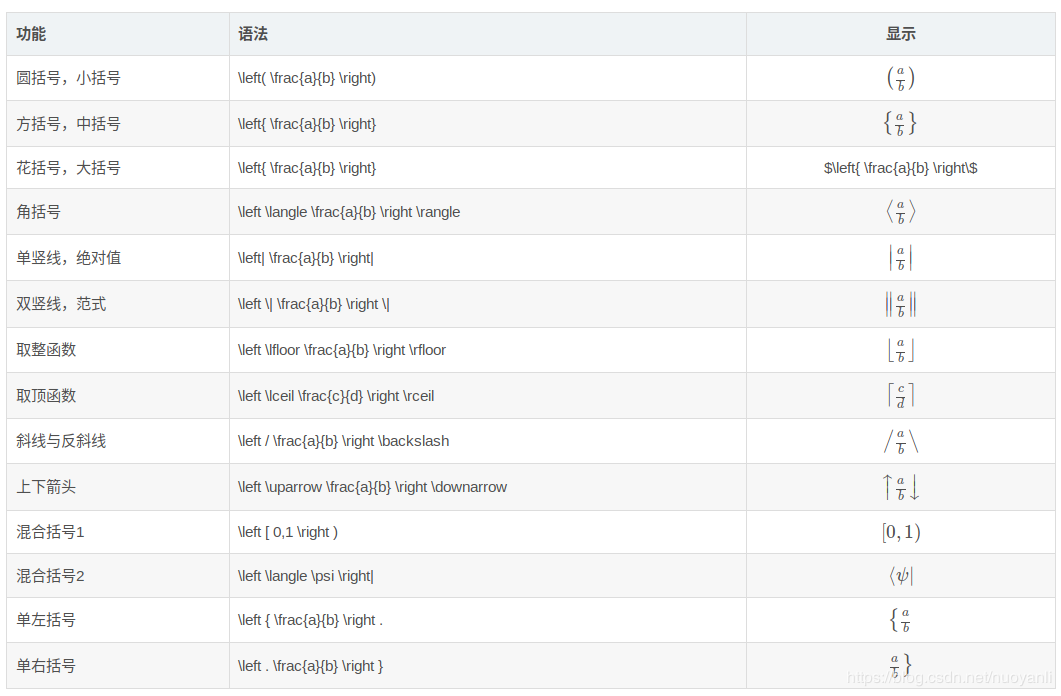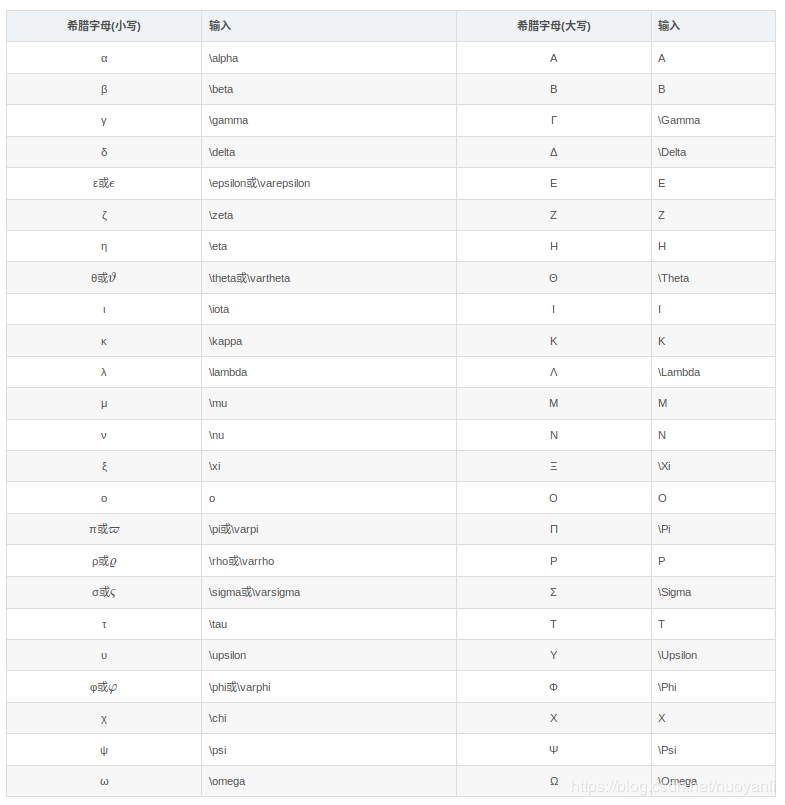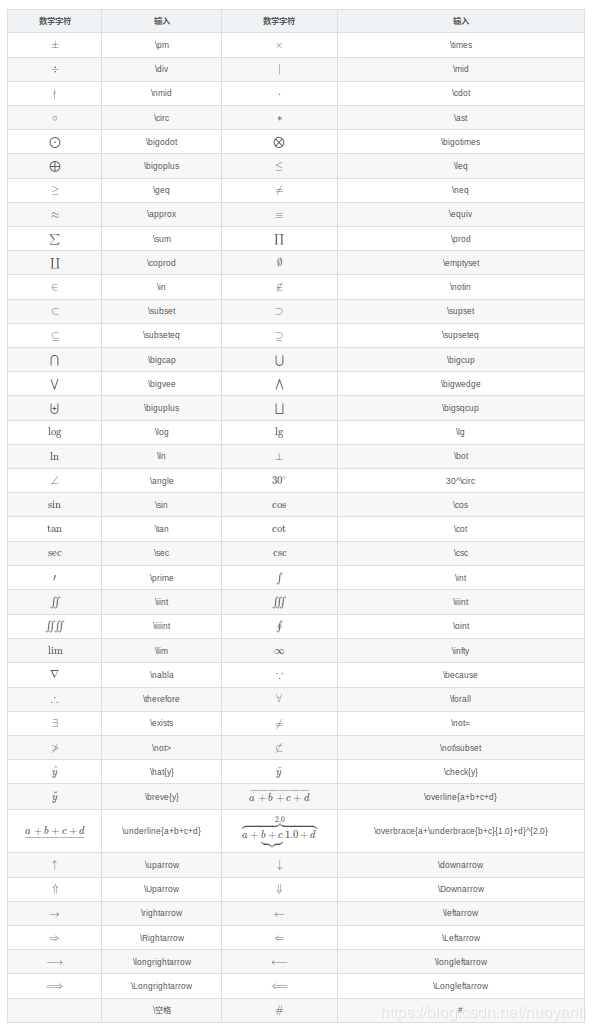Markdown的语法与LaTeX的语法有诸多相似之处,本文使用
$$\begin{matrix}…\end{matrix}$$来写矩阵。
不带括号的矩阵
代码之后的tag实现了后标:
$$
\begin{matrix}
1 & 2 & 3 \\
4 & 5 & 6 \\
7 & 8 & 9
\end{matrix} \tag{1}
$$
写出的效果如下:
147258369(1)
还是喜欢整整齐齐呢!
括号{}的矩阵
$$
\begin{matrix}
1 & 2 & 3 \\
4 & 5 & 6 \\
7 & 8 & 9
\end{matrix} \tag{1}
$$
实现的效果如下:
⎩⎨⎧147258369⎭⎬⎫(2)
括号[]的矩阵
$$
\left[
\begin{matrix}
1 & 2 & 3 \\
4 & 5 & 6 \\
7 & 8 & 9
\end{matrix}
\right] \tag{3}
$$
实现的效果如下:
⎣⎡147258369⎦⎤(3)
不使用left和right关键词
$$
\begin{bmatrix}
1 & 2 & 3 \\
4 & 5 & 6 \\
7 & 8 & 9
\end{bmatrix} \tag{4}
$$
效果:
⎣⎡147258369⎦⎤(4)
而对于大括号而言:
$$
\begin{Bmatrix}
1 & 2 & 3 \\
4 & 5 & 6 \\
7 & 8 & 9
\end{Bmatrix} \tag{5}
$$
得到效果:
⎩⎨⎧147258369⎭⎬⎫(5)
带省略号的矩阵
数学公式中常见的省略号有两种,\ldots表示与文本底线对齐的省略号,\cdots表示与文本中线对齐的省略号。
$$
\left[
\begin{matrix}
1 & 2 & \cdots & 4 \\
7 & 6 & \cdots & 5 \\
\vdots & \vdots & \ddots & \vdots \\
8 & 9 & \cdots & 0 \\
\end{matrix}
\right]
$$
可以看到,对应的符号都是使用\cdots ⋯ 等表示的
⎣⎢⎢⎢⎡17⋮826⋮9⋯⋯⋱⋯45⋮0⎦⎥⎥⎥⎤(6)
带参数的矩阵
这里笔者希望在矩阵中画出一条分割线,以强调最右侧一列的特殊性。
其中\begin{array}{cc|c}中的c表示居中对齐元素
$$
\left[
\begin{array}{cc|c}
1 & 2 & 3 \\
4 & 5 & 6
\end{array}
\right] \tag{7}
$$
效果如下:
[142536](7)
单线矩阵
$$
\begin{vmatrix}
1&2&3\\
4&5&6\\
7&8&9
\end{vmatrix}
\tag{8}
$$
实现效果:
∣∣∣∣∣∣147258369∣∣∣∣∣∣(8)
双线矩阵
$$
\begin{Vmatrix}
1&2&3\\
4&5&6\\
7&8&9
\end{Vmatrix}
\tag{9}
$$
实现效果:
∥∥∥∥∥∥147258369∥∥∥∥∥∥(9)
多元方程对齐
$$
\begin{cases}
a_{11}x_1&+&a_{12}x_2&+&\cdots&+a_{1n}x_n&=&b_1\\
&&&&\vdots\\
a_{n1}x_1&+&a_{n2}x_2&+&\cdots&+a_{nn}x_n&=&b_n&
\end{cases}
$$
效果如下:
⎩⎪⎪⎨⎪⎪⎧a11x1an1x1++a12x2an2x2++⋯⋮⋯+a1nxn+annxn==b1bn(10)
大括号右多行赋值
$$
\left\{\begin{array}{cc}
1, & x=f(Pa_{x})\\
0, & other\ values
\end{array}\right.
$$
实现效果:
{1,0,x=f(Pax)other values(11)
用 cases
$$
P(x|Pa_x)=\begin{cases}
1, & x=f(Pa_{x})\\
0, & other\ values
\end{cases}
$$
实现效果:
P(x∣Pax)={1,0,x=f(Pax)other values(12)
表格
| 标题 | 标题 | 标题 |
|:-|:-:|-:|
|内容左对齐标题|内容居中对齐标题|内容右对齐标题|
实现效果:
| 标题 | 标题 | 标题 |
| 内容左对齐标题 | 内容居中对齐标题 | 内容右对齐标题 |
括号的其他用法

求和符号上下限位置
1、默认情况下:
默认行内公式$\sum_{k=1}^n{x_k}$的上下限标注在右侧: ∑k=1nxk
默认行间公式$$\sum_{k=1}^n{x_k}$$上下限标注在上下: k=1∑nxk(13)
2、可强制修改:
强制行内公式$\sum\limits_{k=1}^n{x_k}$的上下限标注在上下: k=1∑nxk
强制行间公式$$\sum\nolimits_{k=1}^n{x_k}$$上下限标注在右侧: ∑k=1nxk(14)
数学符号字体
斜体加粗 AA:$\boldsymbol{A}$
效果: A
LATEX基本语法
实用LATEX
$ y_k=\varphi(u_k+v_k)$
$J\alpha(x) = \sum{m=0}^\infty \frac{(-1)^m}{m! \Gamma (m + \alpha + 1)} {\left({ \frac{x}{2} }\right)}^{2m + \alpha}$
注意下面的写法:(右对齐)
$$ y_k=\varphi(u_k+v_k)$$
效果如下:
yk=φ(uk+vk)
Jα(x)=∑m=0∞m!Γ(m+α+1)(−1)m(2x)2m+α
注意下面的写法:(右对齐)
yk=φ(uk+vk)(16)
输入上下标
^表示上标, _表示下标。如果上下标的内容多于一个字符,要用{}把这些内容括起来当成一个整体。上下标是可以嵌套的,也可以同时使用。例如:
$x^{y^z}=(1+{\rm e}^x)^{-2xy^w}$
$f(x)=x_2^3+1$
如果要在左右两边都有上下标,可以用\sideset命令...
实现效果:
xyz=(1+ex)−2xyw,f(x)=x23+1(17)
微分方程
$$\frac{du}{dt} and \frac{d^2 u}{dx^2}$$
效果如下:
dtduanddx2d2u(18)
偏微分方程
$$\frac{\partial u}{\partial t}= h^2 \left( \frac{\partial^2 u}{\partial x^2} + \frac{\partial^2 u}{\partial y^2} + \frac{\partial^2 u}{\partial z^2}\right)$$
效果如下:
∂t∂u=h2(∂x2∂2u+∂y2∂2u+∂z2∂2u)(19)
分数
$\frac{1}{3}$
$P(v)=\frac{1}{1+exp(-v/T)}$
效果如下:
31,P(v)=1+exp(−v/T)1(20)
开n次方根
$$\sqrt{2},\sqrt[n]{3}$$
效果如下:
2 ,n3 (21)
向量
$\vec{a} \cdot \vec{b}=0$
实现效果:
a ⋅b =0(22)
积分
$\int_0^1 x^2 {\rm d}x$
实现效果:
∫01x2dx(23)
极限运算
$\lim_{n \rightarrow +\infty} \frac{1}{n(n+1)}$
$\frac{1}{\lim_{u \rightarrow \infty}}, \frac{1}{\lim\limits_{u \rightarrow \infty}}$
实现效果:
n→+∞limn(n+1)1,limu→∞1,u→∞lim1(24)
累加、累乘运算
$\sum_{i=0}^n \frac{1}{i^2}$
$\prod_{i=0}^n \frac{1}{i^2}$
实现效果:
i=0∑ni21,i=0∏ni21(25)
希腊字母

三角函数与逻辑数学字符

感谢你花时间看我的总结,我是nuoyanli,我是热衷于ACM和大数据的技术宅,谢谢大家!







 京公网安备 11010502036488号
京公网安备 11010502036488号